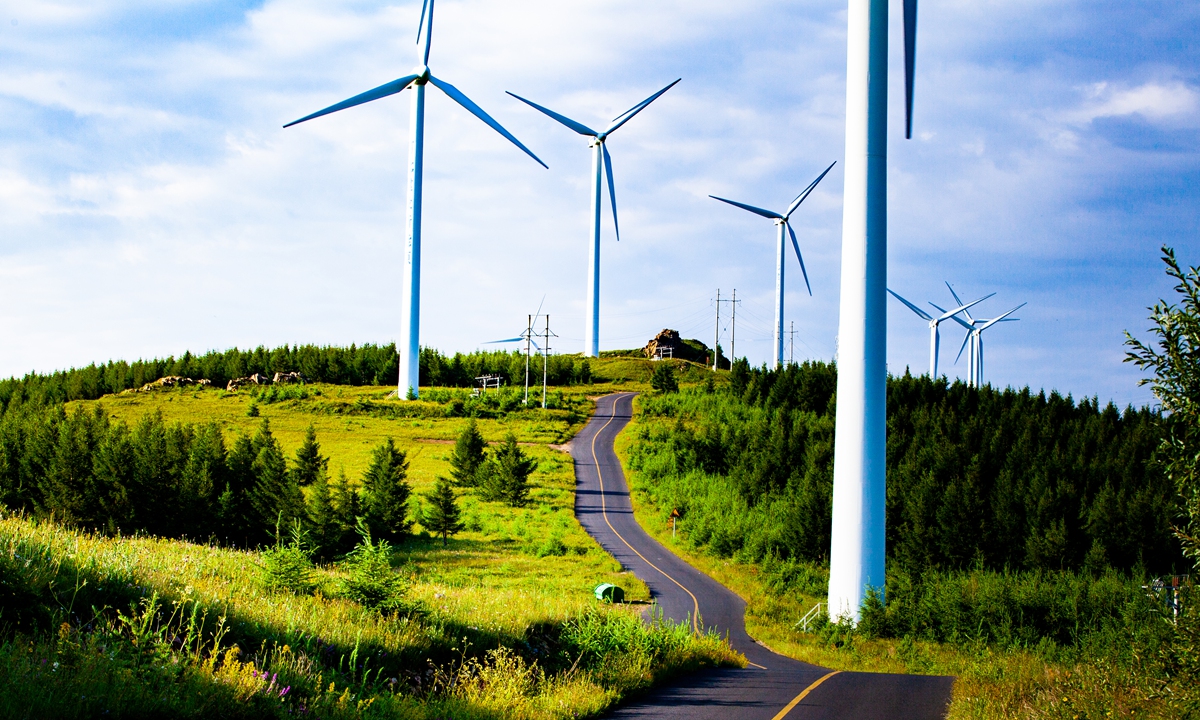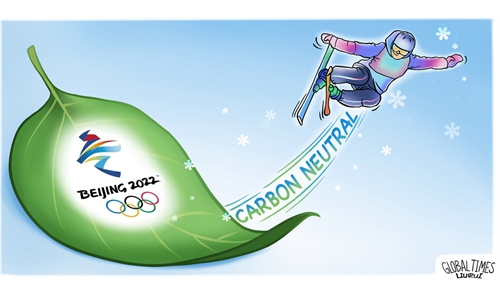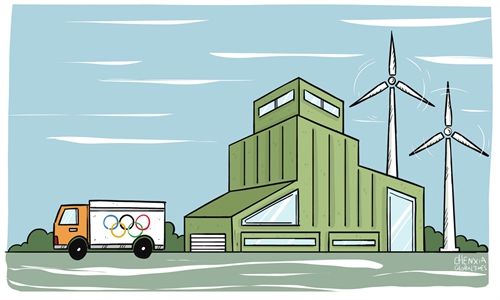How does Zhangjiakou’s wind power light up Olympic venues?
Traditional industrial city hosts world's 'greenest' Games

Grass Skyline Scenic Road in Zhangjiakou, North China's Hebei Province Photo: VCG
The electricity that illuminates the Winter Olympic venues day and night, and makes the Beijing Winter Olympics the greenest Games, along with the hydrogen that powers the 1,200 vehicles shuttling among the Olympic village and different stadiums and stages - the largest use of hydrogen-powered vehicles in Olympic history, both come from Zhangjiakou, a city in North China's Hebei Province that is 180 kilometers from Beijing and also the co-host city for the Games.
The traditional industrial city that used to rely on coal, steel and iron has seen an industrial upgrading with the rapid development of new energy like wind power over the past decade. The wind power is converted into clean electricity and transmitted to all three competition zones for Beijing 2022 through the northern Hebei grid, and there's also a diversified local heating system with renewable and clean energy.
One kilowatt-hour of green electricity can light the main stage of the Beijing Medals Plaza for 22 seconds, provide electricity for chefs to make two dishes in the kitchen of the Olympic village, or power the electric heater in a solar-powered inflatable tent for 30 to 40 minutes, according to State Grid.
To ensure that 26 venues in the three competition zones for Beijing 2022 are powered 100 percent by green energy for the first time in history, Zhangjiakou established the world's first renewable energy-based flexible direct-current power transmission system, which is highly reliable and does not need support from conventional electricity, Liang Lixin, a representative from the new energy company with State Grid's Hebei electric power company, told the Global Times.
The new system is capable of transmitting about 14.1 billion kilowatt-hours of power to Beijing annually, accounting for 10 percent of Beijing's annual electricity consumption. This means that Beijing will save 4.9 million tons of standard coal and avoid emissions of 12.8 million tons of carbon dioxide every year.
In recent interviews with Chinese media, Juan Antonio Samaranch, chairman of the International Olympic Committee Coordination Commission for the Beijing 2022 Olympic Winter Games, praised China's steps to make the Beijing Winter Olympics green, saying it will be the greenest Games.
Besides green electricity, Beijing 2022 has also seen the largest use of hydrogen-powered vehicles with 1,200 being deployed in the three competition zones.
In the first five days of the Games, Zhangjiakou's two hydrogen production plants and eight hydrogen refueling stations provided a total of 27 tons of hydrogen for 837 vehicles in the city, including 710 vehicles with 22 tons of hydrogen for the Zhangjiakou competition zone, said Wang Hewu, executive director of the Zhangjiakou Hydrogen and Renewable Energy Research Institute.
He said such vehicles only emit pure water, unlike diesel-powered vehicles that emit polluting particles.
Zhangjiakou is a national wind and solar energy storage and transmission demonstration project zone, and it aims to become an international hydrogen city by 2035.
The wind energy in Zhangjiakou supports the Olympics, and it also provides a long-term green solution to the development of the city in the post-Olympics era.
Sun Yong, a professor at Hebei University of Architecture, told the Global Times that the whole city is promoting heating with wind, replacing coal-fired heating that emitted pollutants.
The university adopted a wind heating system in 2019. The boiler room in the university used to be covered in coal ash and workers had to wear heavy protective gear some 10 years ago, but the same boiler room the Global Times visited recently looked like a new exhibition hall with a clean electricity boiler and no choking smells or fumes.
The wind energy also facilitates the development of local tourism as the windmills that turn wind into power were built in Zhangbei county of Zhangjiakou, which is home to a famous scenic spot Grass Skyline, nicknamed "China's Route 66."
The 133-kilometer scenic road, located at the junction of Zhangbei county and Chongli county, also passes through grasslands, farm fields and cliffs that attracts millions of tourists every year.
From a heavy industrial city with black smoke and sewage to a green city contributing to a green Olympics, many were amazed by the transformation of Zhangjiakou, including local residents.
Liu Dianli, 58, an employee with the Zhangjiakou Industrial Culture Park in the downtown area, where the Zhangjiakou coal mining machinery company was located before 2013, told the Global Times that he grew up with sandstorms and black smoke from chimneys, and the park areas were filled with dirt 10 years ago.
Liu said applying for co-hosting the Olympics provided Zhangjiakou with a chance to transform, and the city has relocated the coal factories to an industrial park.
All factories have had to meet emission standards, and the sand and smoke have gone in recent years.
"One of my impressions is that more people have started to wear light-colored down jackets in winter, which shows Zhangjiakou's achievement in managing the environment," Liu said.
However, some media hyped the pollution issue during the Winter Olympics with some saying that China "closed factories" in Hebei Province for blue skies.
In response to these allegations, local residents said that what these media outlets need to do is to send their journalists to visit Beijing and Zhangjiakou, and they would see that China is taking actual action to improve its environment.
Liu said that as far as he knew, no factories in Zhangjiakou were shut down for Beijing 2022, as they had already met the emission standard.



